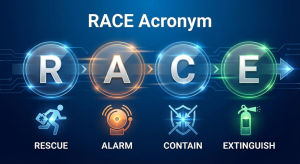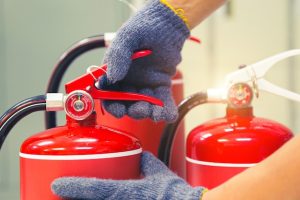Introduction
Fire safety is paramount in both homes and workplaces. One of the most essential tools for fire safety is the fire extinguisher. However, having a fire extinguisher is not enough to understanding how to use it and knowing what the letters and numbers on it mean can make a significant difference in an emergency. This guide aims to provide an in-depth understanding of the alphanumeric system used on fire extinguishers to ensure you are well-prepared to handle different types of fires effectively and safely.
The Importance of Fire Extinguishers
Fire extinguishers are a crucial first line of defense in the event of a fire. They are designed to combat fires at their inception, preventing small fires from growing into uncontrollable blazes. However, the effectiveness of a fire extinguisher depends on using the right type for the specific kind of fire you are dealing with. Misusing an extinguisher can lead to ineffective firefighting or even exacerbate the situation, making it more dangerous.
Understanding Fire Classes
Fires are classified into different types based on the fuel source that is burning. The letters on fire extinguishers indicate the class of fire they are designed to combat. Here’s a detailed look at each class:
Class A Fires
Class A fires are the most common and involve ordinary combustibles such as wood, paper, cloth, and some plastics. These fires are typically found in homes, offices, and schools. Class A fire extinguishers are usually water-based, which works by cooling the burning material and reducing its temperature below its ignition point.
- Water Extinguishers: These are filled with water and pressurized air, making them effective against Class A fires. They are not suitable for other fire classes and can be dangerous if used on Class B or C fires.
- Foam Extinguishers: These can also handle Class A fires and work by forming a blanket over the fire, cutting off the oxygen supply.
- Dry Chemical Extinguishers: Often labeled as ABC extinguishers, they can handle Class A, B, and C fires, making them versatile and widely used.
Class B Fires
Class B fires involve flammable liquids and gases such as gasoline, oil, paint, propane, and butane. Water is not effective against these fires and can even spread the flammable liquid, making the fire worse.
- Foam Extinguishers: These are effective for Class B fires by creating a barrier between the fire and the air, smothering the flames.
- Carbon Dioxide (CO2) Extinguishers: These work by displacing oxygen around the fire and cooling the burning material, leaving no residue.
- Dry Chemical Extinguishers: These can be used on Class B fires and are also effective for Class A and C fires.
Class C Fires
Class C fires are electrical fires that involve energized electrical equipment such as motors, transformers, and appliances. Water-based extinguishers are dangerous to use on these fires as water conducts electricity and can cause electrical shocks.
- Carbon Dioxide (CO2) Extinguishers: These are ideal for electrical fires as they leave no residue and do not conduct electricity.
- Dry Chemical Extinguishers: These are safe for use on electrical fires and are also effective against Class A and B fires.
Once the electrical source is shut off, the fire can then be treated as a Class A or B fire, depending on the materials involved.
Class D Fires
Class D fires involve combustible metals such as magnesium, titanium, sodium, and potassium. These fires are rare in most homes but are a significant risk in laboratories and industrial settings.
- Dry Powder Extinguishers: These are specifically designed for Class D fires. The powder separates the fuel from the oxygen, absorbs heat, and cools the metal.
Class K Fires
Class K fires, also known as kitchen fires, involve cooking oils and fats. These fires are common in commercial kitchens but can also occur in residential settings. Water is particularly dangerous on these fires as it can cause the burning oil to splatter and spread.
- Wet Chemical Extinguishers: These are designed to cool the fire and form a soapy foam blanket over the burning oil or fat, cutting off the oxygen supply and preventing re-ignition.
Understanding Fire Extinguisher Ratings
The numbers on fire extinguishers indicate their size and effectiveness. This numerical rating helps users understand how much fire the extinguisher can handle.
Class A Ratings
For Class A fires, the number before the “A” indicates the extinguisher’s effectiveness relative to 1 ¼ gallons of water. For example:
- 2A: This rating means the extinguisher is equivalent to 2 ½ gallons of water.
- 4A: This rating means the extinguisher is equivalent to 5 gallons of water.
The higher the number, the more fire the extinguisher can combat.
Class B Ratings
For Class B fires, the number before the “B” indicates the approximate square footage of the fire that can be extinguished by a non-expert user.
- 10B: Effective on 10 square feet of fire.
- 20B: Effective on 20 square feet of fire.
These ratings assume the user will apply the extinguishing agent evenly over the surface of the flammable liquid fire.
Multi-Class Ratings
Some fire extinguishers are designed to handle multiple classes of fires. These multi-class extinguishers are labeled with a combination of letters and numbers, indicating their effectiveness against different types of fires.
- 2A:10B:C: This rating means the extinguisher is effective against Class A fires equivalent to 2 ½ gallons of water, can cover 10 square feet of a Class B fire, and is safe for use on electrical equipment (Class C).
Choosing the Right Fire Extinguisher
Selecting the right fire extinguisher involves understanding the types of fires that could potentially occur in your environment and choosing an extinguisher that can effectively combat those fires.
- Identify Potential Fire Hazards: Assess your environment to identify potential fire hazards and ensure you have the appropriate type of extinguisher for each area.
- Consider Extinguisher Capacity: Larger areas or places with a higher risk of fire should have extinguishers with higher ratings.
- Accessibility: Ensure fire extinguishers are easily accessible and not obstructed. In an emergency, quick access is crucial.
- Training: Make sure everyone in your home or workplace knows how to use a fire extinguisher. The PASS technique (Pull, Aim, Squeeze, Sweep) is a simple method to remember.
Maintenance and Inspection
Regular maintenance and inspection of fire extinguishers are essential to ensure they function properly when needed. Here are some tips for maintaining your fire extinguishers:
- Monthly Visual Inspections: Check for any signs of damage, corrosion, or leakage. Ensure the pressure gauge is in the operable range.
- Annual Professional Inspections: Have a professional inspect and service your fire extinguishers annually. They will check the internal pressure, refill if necessary, and ensure all components are working correctly.
- Recharge After Use: Even if an extinguisher is partially used, it should be recharged by a professional to ensure it is fully operational for the next use.
- Replace Expired Extinguishers: Fire extinguishers have a lifespan, usually 5-15 years. Check the manufacturer’s recommendations and replace extinguishers that have reached their expiration date.
Proper Use of Fire Extinguishers
Knowing how to use a fire extinguisher is as important as having one. The PASS technique is a straightforward method to remember:
- Pull the Pin: This unlocks the operating lever and allows you to discharge the extinguisher.
- Aim Low: Point the nozzle or hose at the base of the fire. This targets the fuel and not the flames.
- Squeeze the Lever: This discharges the extinguishing agent. Release the lever to stop the discharge.
- Sweep Side to Side: Move the nozzle from side to side at the base of the fire until it is extinguished.
It is crucial to ensure you have a clear escape route and to evacuate immediately if the fire becomes uncontrollable or if the room fills with smoke.
Conclusion
Understanding the letters and numbers on your fire extinguisher can be the difference between effectively combating a fire and making a dangerous situation worse. By knowing the class of your extinguisher and the size of fire it can fight, you’ll be better equipped to safely protect yourself and your property from fire.
For more detailed information on fire safety and choosing the right extinguisher, you can visit the National Fire Protection Association (NFPA) website. Additionally, the U.S. Fire Administration provides valuable resources on fire prevention and safety, available here.
Stay safe, stay informed, and ensure your fire extinguishers are always ready to protect you when you need them most. Proper knowledge and preparation can significantly reduce the risk and impact of a fire, safeguarding lives and property.
Fire Safety FAQs: Choosing, Using and Refilling Extinguishers
Q1: What are the 4 classes of fire extinguishers?
Fire extinguishers are classified as Class A for ordinary materials, Class B for flammable liquids, Class C for electrical fires, and Class D for combustible metals. Each class is designed to handle specific fire risks safely.
Q2: Which is better, ABC or CO₂ fire extinguisher?
ABC extinguishers are more versatile for general use, while CO₂ extinguishers excel in electrical areas because they leave no residue. The better choice depends on your environment, fire risks present, and cleanup concerns after discharge.
Q3: Looking for where to fill CO₂ tank near me in the USA?
If you’re searching for where to fill CO₂ tank near me in the USA, Serviced Fire Equipment is a service offering certified refilling, safety inspections, and pressure testing to help ensure tanks meet safety and compliance standards nationwide.
Q4: What’s the best fire extinguisher for home use?
An ABC-rated fire extinguisher is the best choice for most homes. It effectively handles paper, flammable liquids, and electrical fires, offering broad protection in kitchens, garages, and living spaces with reliable performance and easy availability.
Q5: Is Purple K fire extinguisher better than ABC fire extinguisher?
Purple K extinguishers are extremely effective on flammable liquid and gas fires, especially in industrial and commercial kitchens. However, ABC extinguishers provide wider protection for everyday environments where multiple fire risks commonly exist together.
Q6: What kind of fire extinguisher is not allowed in kitchens?
Water-based Class A fire extinguishers are not suitable for kitchens. They can cause dangerous flare-ups when used on grease fires and pose serious electrical shock risks around appliances, making them unsafe for kitchen fire protection.







